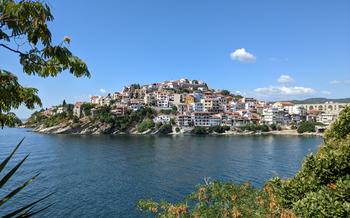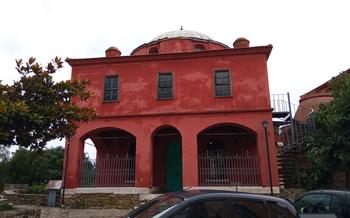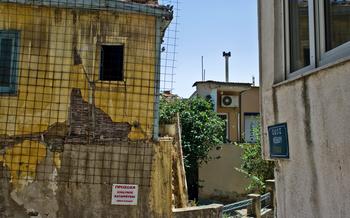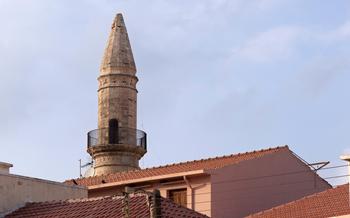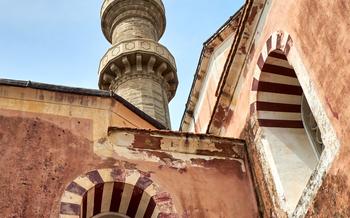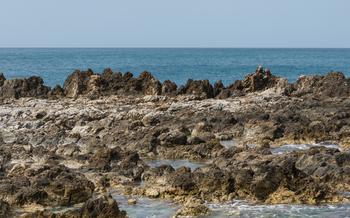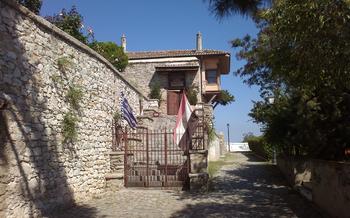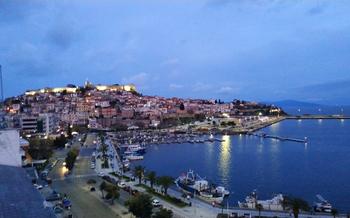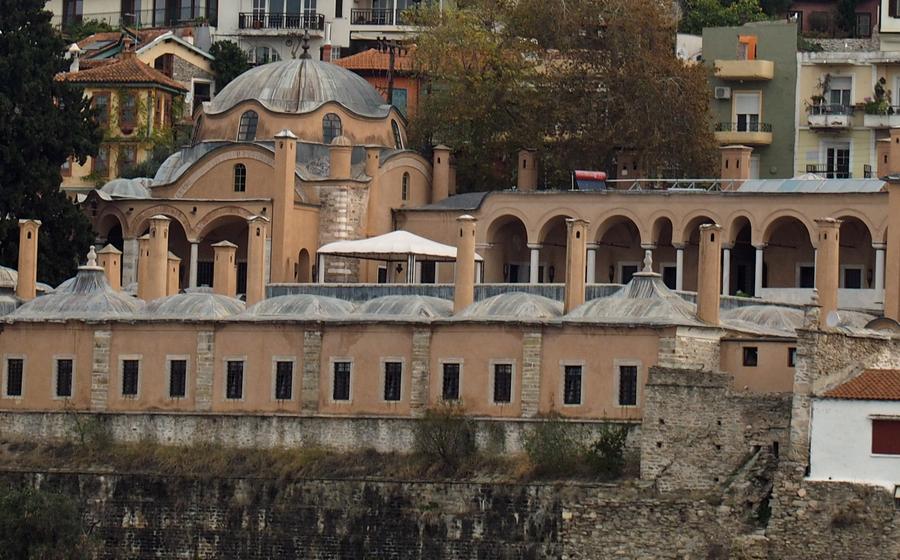
The Imaret
- A City with History
- The Imaret's Location
- The Building's Architecture
- The Imaret Today
- Things to See
- Things to Do
- Tips for Visitors
- The Imaret's Legacy
- Local Traditions and Customs
- Local Cuisine and Flavors
- Off-the-Beaten-Path Gems
- Insider Tip: Unveiling Hidden Treasures
A City with History
Kavala, a city steeped in history and charm, boasts a rich tapestry of cultural influences that have shaped its unique identity. Strategically located on the Aegean coast, Kavala has served as a crossroads for civilizations throughout the centuries, leaving behind a legacy of architectural wonders, including the magnificent Imaret. This iconic building stands as a testament to the city's vibrant past and serves as a reminder of its enduring spirit.
The Imaret's architectural style is a testament to the blending of cultures that has occurred in Kavala. Constructed during the Ottoman period, the building showcases a harmonious fusion of Islamic and Byzantine design elements. Its intricate stonework, graceful arches, and elegant domes evoke a sense of grandeur and artistry that captivates visitors from the moment they set foot within its walls.
Originally conceived as a charitable institution, the Imaret served as a place of refuge and support for those in need. Its spacious courtyard provided a welcoming space for travelers, students, and the poor to find shelter, food, and education. The Imaret's legacy of compassion and generosity has left an enduring mark on the city, contributing to its reputation for hospitality and warmth.
The Imaret's Location
The Imaret is situated at the heart of Kavala's Old Town, on Nikiforou Fokou Street, adjacent to the picturesque port. Its prominent location offers easy access and proximity to other significant landmarks and attractions in the area. Visitors can conveniently explore the Old Town's labyrinthine streets, lined with traditional houses, shops, and tavernas, discovering hidden gems and soaking up the city's vibrant atmosphere.
The Imaret is well-connected by public transportation, with bus stops within walking distance. For those arriving by car, ample parking options are available in the vicinity, ensuring a hassle-free visit. Whether exploring Kavala on foot or by vehicle, the Imaret's central location makes it an ideal starting point for a comprehensive tour of the city.
The Building's Architecture
The Imaret stands out with its distinct architectural features, blending Ottoman and Byzantine influences. Its exterior boasts a series of domes, arches, and intricate stone carvings that showcase the craftsmanship of its builders. The central courtyard, a defining element of Islamic architecture, serves as a serene oasis, surrounded by arched galleries and a stunning fountain. Inside, visitors can admire the intricate details and design choices that reflect the building's rich history. The Imaret's interior layout is characterized by a series of interconnected rooms and halls, each with its own unique purpose and design. Notable architectural elements include the ornate mihrab, a niche indicating the direction of Mecca, and the intricately carved wooden ceilings. The use of local materials, such as stone and wood, contributes to the building's authenticity and connection to its surroundings.
The Imaret Today
The Imaret has undergone extensive restoration and renovation efforts in recent years, transforming it into a vibrant cultural hub that celebrates the rich heritage of Kavala. Today, the building stands as a testament to the city's architectural prowess and serves as a multi-faceted venue for cultural events, exhibitions, and community gatherings.
The Imaret's grand courtyard, with its intricate arches and serene atmosphere, often hosts concerts, performances, and traditional dance shows, showcasing the vibrant artistic talent of the region. Inside, the building's spacious halls and galleries house temporary exhibitions that delve into the history, culture, and art of Kavala and Greece. These exhibitions provide a platform for local artists to showcase their works and for visitors to gain insights into the city's rich cultural tapestry.
Beyond its role as a cultural venue, the Imaret also houses a library, a research center, and educational facilities, fostering intellectual pursuits and lifelong learning within the community. The library boasts an impressive collection of books, manuscripts, and documents related to Kavala's history, providing a valuable resource for researchers, students, and history enthusiasts.
The Imaret's transformation into a cultural center has not only breathed new life into the historic building but has also contributed to the revitalization of the surrounding neighborhood. The Imaret has become a focal point for cultural tourism, attracting visitors from around the world who seek to immerse themselves in the city's rich heritage.
Things to See
The Imaret's architectural marvels are a sight to behold. Upon entering, the stunning courtyard, adorned with a mesmerizing fountain and lush greenery, welcomes visitors. Gaze upon the elegant mosque, a testament to the city's rich Islamic heritage, and marvel at its intricate tilework and graceful minaret piercing the sky. The clock tower, a symbol of Kavala's precision, stands tall, offering panoramic vistas of the city and its surroundings.
Intricate details and decorative elements adorn every corner of the Imaret. Notice the delicate carvings and calligraphy that embellish the walls, each stroke narrating a chapter of the building's storied past. Stained-glass windows cast a kaleidoscope of colors, illuminating the interior with an ethereal glow.
Don't miss the historical artifacts and exhibits that provide a glimpse into the Imaret's multifaceted history. Learn about the charitable deeds performed within these walls, the cultural exchanges that took place, and the significant role the Imaret played in shaping the identity of Kavala.
Things to Do
The Imaret offers visitors a range of engaging activities to immerse themselves in the cultural and historical significance of the building. Participate in educational workshops and demonstrations that showcase traditional crafts, such as pottery, weaving, and metalworking, gaining hands-on experience and insights into the rich artistic heritage of Kavala. Attend cultural performances, concerts, and exhibitions held within the Imaret's historic walls, showcasing the talents of local artists and performers. The Imaret's serene courtyard provides an idyllic setting for relaxation and contemplation. Take a moment to savor the tranquility of the surroundings, soak in the architectural beauty, and let the ambiance transport you back in time. Join guided tours led by knowledgeable historians or explore the Imaret independently, delving into its captivating narratives and intricate details at your own pace. Don't miss the opportunity to ascend the Imaret's clock tower, offering panoramic views of Kavala and the surrounding landscape, capturing the essence of this vibrant city from a unique perspective.
Tips for Visitors
Plan your visit to the Imaret during the shoulder season (April-May or September-October) to avoid the summer crowds and experience the city at its most peaceful. Allow yourself at least an hour to fully appreciate the Imaret's grandeur and explore its various sections, including the courtyard, mosque, clock tower, and exhibition spaces.
Combine your visit to the Imaret with other nearby attractions such as the Old Town, the Archaeological Museum, and the Tobacco Museum for a comprehensive tour of Kavala's history and culture.
After your visit, head to the nearby market streets to find souvenirs and local products related to the Imaret, such as postcards, replicas of the building, and traditional handicrafts. These items serve as a reminder of your time in Kavala and help support local artisans and businesses.
The Imaret's Legacy
Standing as a testament to Kavala's rich past, the Imaret has made an indelible mark on the city's development and cultural identity. Its unique architectural style, historical significance, and role as a charitable institution have earned it widespread recognition and accolades. The Imaret has been recognized as a national monument and has received numerous awards for its preservation efforts.
The Imaret's legacy extends beyond its physical structure. It has played a vital role in shaping Kavala's cultural identity, embodying the city's historical ties to the Ottoman Empire and its diverse cultural influences. The Imaret has served as a source of inspiration for local artists, writers, and musicians, who have found creative expression in its unique ambiance and architecture.
In recent years, the Imaret has undergone extensive restoration and preservation efforts, ensuring its continued existence for future generations. These efforts have been lauded by both local and international organizations, recognizing the Imaret's significance as a cultural heritage site. The ongoing preservation efforts aim to not only maintain the building's structural integrity but also to protect its historical and cultural value.
Local Traditions and Customs
The Imaret is deeply embedded in the local traditions and customs of Kavala. It holds a significant place in the city's folklore and legends, with stories passed down through generations. Locals view the Imaret as a symbol of their cultural heritage and a testament to the city's rich history.
One of the most prominent traditions associated with the Imaret is the annual celebration of the "Feast of the Imaret." This festival takes place every year on May 26th and features traditional music, dancing, and food. The Imaret's courtyard transforms into a lively gathering place, where locals and visitors come together to celebrate the city's cultural heritage.
The Imaret also plays a role in local religious customs. During the holy month of Ramadan, the building is often used for communal prayers and gatherings. The Imaret's serene atmosphere provides a peaceful sanctuary for Muslims to observe their religious practices.
By participating in traditional events and festivals held at the Imaret, visitors can gain a deeper understanding of the cultural context of the building and the local community. Immersing oneself in these traditions allows visitors to connect with the heart and soul of Kavala and experience the city's unique cultural tapestry.
Local Cuisine and Flavors
When visiting Kavala, immersing yourself in the local culinary scene is a must. The city is renowned for its fresh seafood, delectable olive oil, and aromatic herbs that infuse traditional Greek dishes with a unique flavor. To truly savor the essence of Kavala, venture into the charming alleys near the Imaret, where you'll find traditional tavernas and family-run restaurants that have been serving authentic Greek cuisine for generations. Indulge in mouthwatering dishes like "saganaki" (fried cheese), "souvlaki" (grilled meat skewers), and "moussaka" (a hearty eggplant and potato casserole). Pair your meal with a glass of local wine or "ouzo," a traditional anise-flavored spirit, for a complete culinary experience. Don't forget to sample the region's famous olives and olive oil, which add a distinctive flavor to every dish. Embrace the opportunity to savor the rich flavors of Kavala and create lasting memories that will transport you back to this culinary paradise.
Off-the-Beaten-Path Gems
Beyond the Imaret's captivating allure, Kavala offers a treasure trove of hidden gems waiting to be discovered. Venture off the beaten path and explore the surrounding neighborhoods to uncover a tapestry of local markets, artisan workshops, and traditional tavernas. Immerse yourself in the authentic charm of Kavala as you stroll through narrow cobblestone streets, admire picturesque architecture, and engage with friendly locals. Discover unique experiences that paint a vivid portrait of the city's rich heritage and vibrant culture. Whether it's browsing for handmade crafts, savoring delectable local cuisine, or simply soaking in the atmosphere, these hidden gems offer a glimpse into the true essence of Kavala. Embrace the opportunity to explore beyond the Imaret and unearth the city's hidden treasures that await those willing to venture off the beaten path.
Insider Tip: Unveiling Hidden Treasures
As you explore the Imaret, keep an eye out for a hidden gem tucked away within its walls. Ascend to the building's rooftop, where you'll discover a secluded terrace that offers a breathtaking panorama of Kavala. This vantage point allows you to soak in the city's charm, with its red-tiled roofs, azure waters, and lush greenery. Capture stunning photographs of the cityscape, ensuring you have a lasting memento of your visit to this historic landmark.
